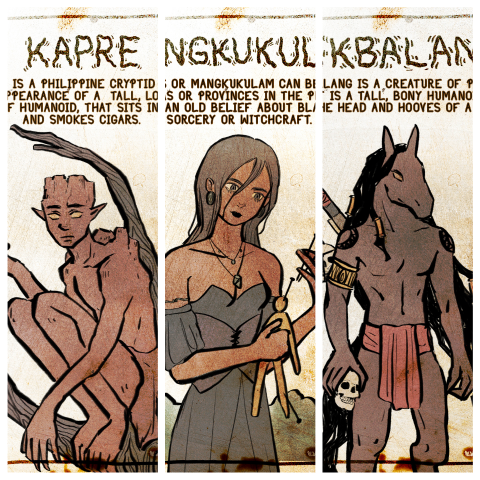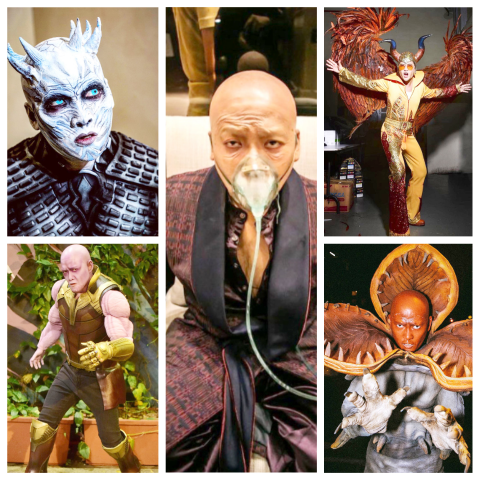Shake, rattle, and ball
Whoever has not heard of the kapre, tikbalang, manananggal, or tiyanak, please raise your hand.
By AA Patawaran
At A Glance
- The theme is subject to interpretation. The Pinoy theme is very rich they can either be grotesque or pursue a fantasy. —Tim Yap

These creatures—mythical to some, as real to others as the mayas perched on the treetops—have haunted the dark corners of the archipelago for centuries before Magellan set foot on Philippine shores in 1521. Not even the propagation of Christianity has diminished their power over the Filipino imagination. On the contrary, the conversion added multiple layers to our impression of the occult and the supernatural.
On Oct. 30, these creatures of magic, invisible forces of nature, come out to play at the Natural Museum of Anthropology on the occasion of Tim Yap’s annual exploration of Halloween, ahead of the observance of the Day of the Dead, Araw ng Mga Patay, on Nov. 1 and All Souls Day, Araw ng mga Kaluluwa, on Nov. 2.
Incidentally, his Halloween party on Oct. 30 is also an advanced peek into “Alamat,” the joint exhibition of contemporary artists headed by National Artist for the Visual Arts Kidlat Tahimik and sculptor, street artist, fashion designer, production manager, and jewelry maker Leeroy New, at the Marble Hall and courtyard of the museum. Both artists are masters of the eerie, the macabre, and the sublime.
Come as your worst nightmare, which is exactly the shape and form of every elemental, whether higante or dwende, whether pugot, a headless giant, or walo, Maranao’s eight-headed, thousand-eyed hairy giant, who guards a section of heaven holding the jarred souls of all humans. Or come as your best fantasy, a being of light, a diwata, or a winged creature of immense beauty, or the harbingers of dreams.
There are more than 140 ethnic groups in the Philippines and each of them has their own set of beasts, monsters, and creatures that represent earth, wind, fire, and water, the four elements of the planet, but there is also the element of space that in the Philippines is haunted by the shadows of the dead, a beheaded priest on horseback, a woman in white, a baby in distress…
Horror, an expression of the ultimate evil, as well as magical beings, is not unique to the Philippines, but with centuries of ancient animism, defined as the attribution of a soul to plants, inanimate objects, and natural phenomena, in our pre-colonial past, horror for the Filipino has its own distinct size, shape, voice, appearance, and evildoing. It’s a mystery we have not made quite a global export of Philippine horror yet.

Every Halloween, Tim Yap, a mover and shaker of Philippine culture, seizes the opportunity to lay bare deeper—perhaps otherwise hidden, repressed, or kept under lock and key—interpretations of the self.
“Each year I push a theme that I feel is within the social consciousness of its time,” he says. “Like one year, right before the pandemic, it was ‘Apocalypse’ and then after the pandemic, it was ‘Dystopia.’ Now I am planning to collectively call it ‘Shake, Rattle, and Ball.’ I will just change themes yearly, depending on what we are going through.”
His choice of theme this year is an homage not only to Philippine folklore and mythology, but also how they reflect on our culture and our evolution. “The core is to be creative,” says Tim. “I want to make something deeper, more meaningful, and rooted to culture and share it with everyone, but I also want [the participants] to realize that the theme is subject to their interpretation… and that the Pinoy theme is very rich they can either be grotesque or pursue a fantasy.”
This year’s Halloween celebration is also unprecedented, “A Night at the Museum,” which we ourselves, the partygoers, can craft into our very own with our deep reserves of creativity and imagination drawn both from the glories and the horrors of our past, present, and future.
It is also unprecedented in that this is the first time Tim’s Halloween party will launch an art exhibition, “Alamat,” featuring Kidlat Tahimik, Leeroy New, and other artists. To open to the public the next day, Oct. 31, the exhibit will run at the National Museum of Anthropology until December.
“It’s also my first time to do it at a museum,” adds Tim. “The guest list is smaller since we have to respect the space, but I’m happy I get to pull people into a structure that has been around since the 1940s and not been visited by many of our friends.”